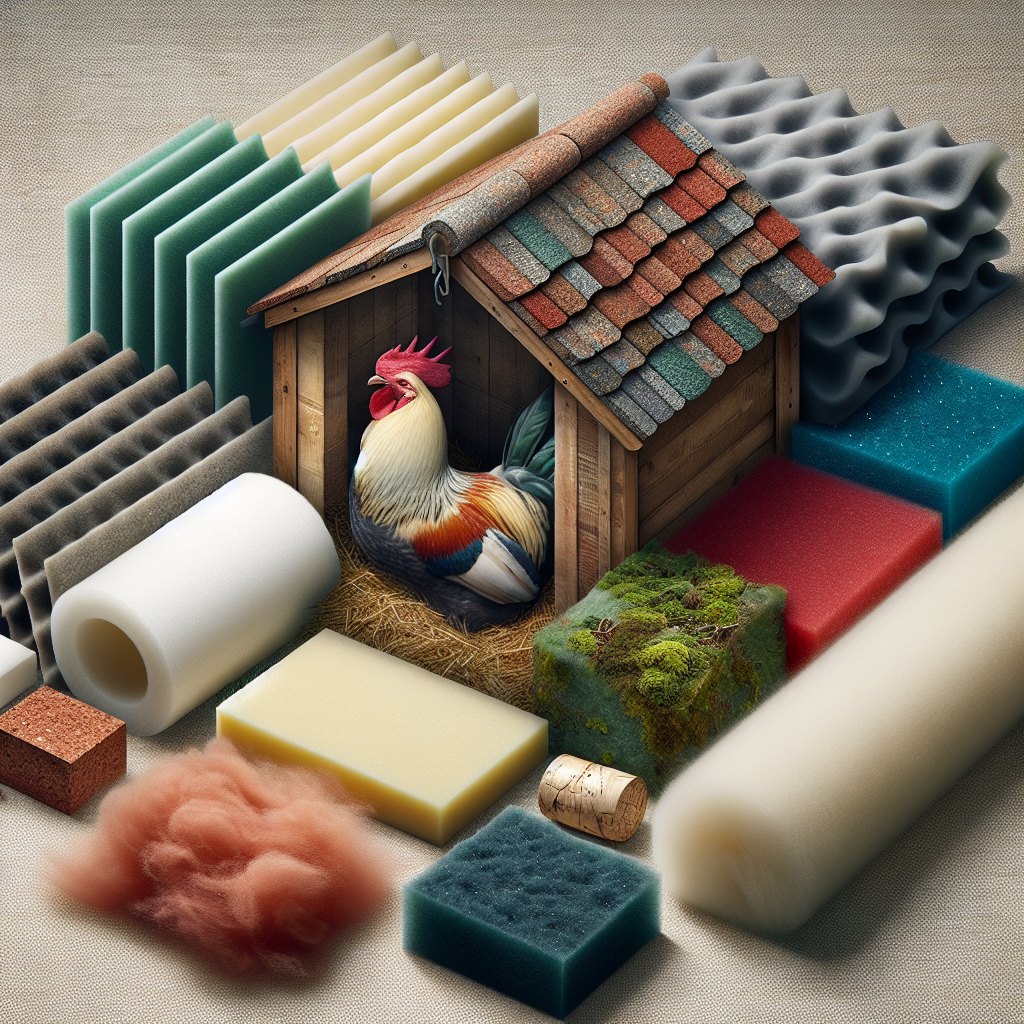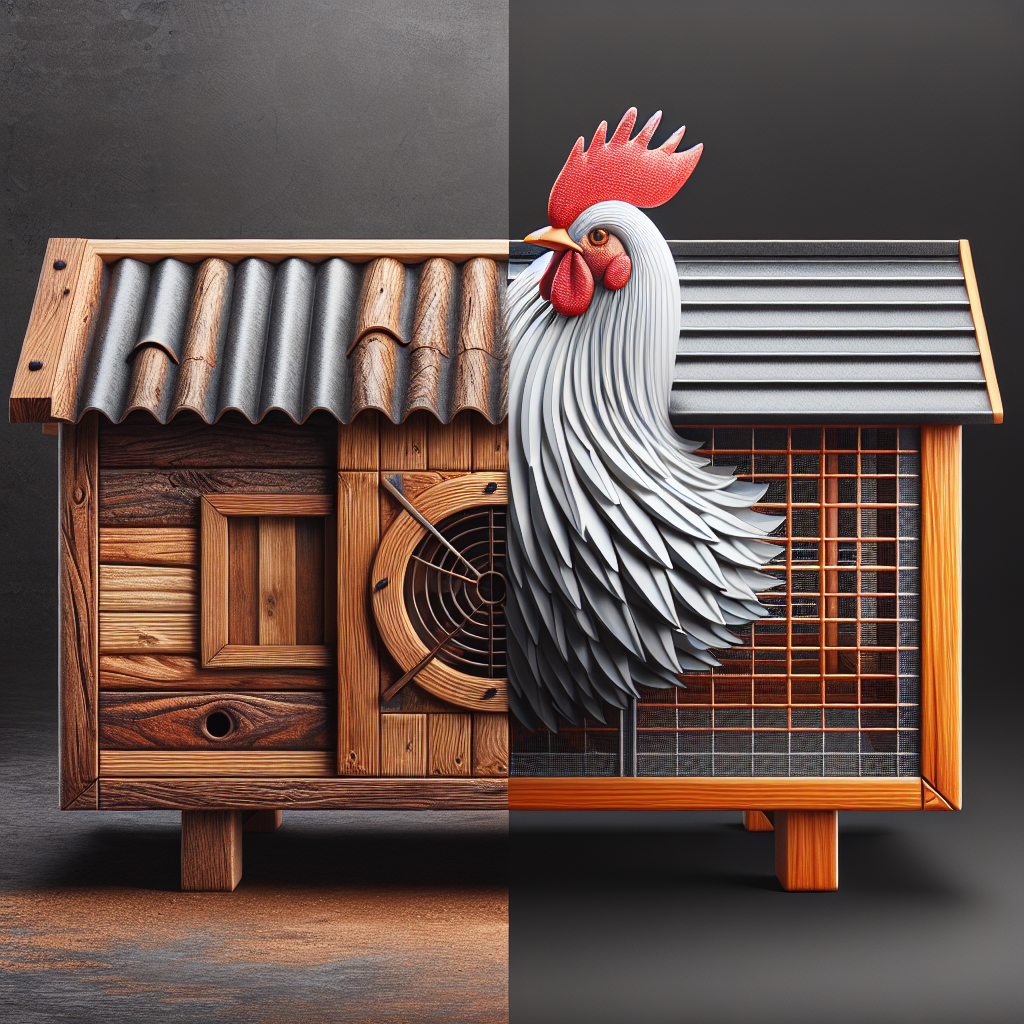Are you curious about whether there are materials that can naturally resist pests and insects in coops? Look no further! In this article, we will explore the possibility of using materials that naturally deter these unwanted guests. We will discuss the effectiveness of such materials, the benefits they offer, and how they can contribute to maintaining a healthy and pest-free environment for your coop. So, if you’re ready to find out more about this exciting topic, let’s get started!
Introduction
When it comes to maintaining healthy and productive coops, dealing with pests and insects can often be a significant challenge. However, finding effective and safe methods for pest control is crucial for the well-being of your animals and the overall sustainability of your coop. Fortunately, there are a variety of natural materials that can provide pest and insect resistance without the need for harmful chemical pesticides. In this article, we will explore the importance of natural pest and insect resistance in coops and discuss the common pest and insect problems that coop owners face. Additionally, we will delve into the various natural materials available for pest control and their benefits and limitations. Finally, we will discuss the implementation of these materials in coops and share case studies of successful practices. We will conclude by looking into the future directions and research needed to further improve natural pest and insect resistance in coops.
1. Importance of Natural Pest and Insect Resistance in Coops
1.1 Enhancing the Health and Welfare of Animals
One of the primary reasons for implementing natural pest and insect resistance measures in coops is to enhance the health and welfare of the animals. Infestations by pests such as mites and lice can cause significant discomfort and stress to chickens and other animals. By utilizing natural materials that repel or control these pests, coop owners can ensure that their animals remain healthy and free from unnecessary suffering.
1.2 Reducing Reliance on Chemical Pesticides
Another crucial reason for adopting natural pest and insect resistance in coops is to reduce reliance on chemical pesticides. Chemical pesticides can have detrimental effects not only on pests and insects but also on the environment and the health of animals and humans. By using natural materials instead, coop owners can minimize the use of harmful chemicals and promote a more sustainable approach to pest control.
1.3 Promoting Environmental Sustainability
Implementing natural pest and insect resistance measures in coops also aligns with the principles of environmental sustainability. Chemical pesticides can have negative impacts on the surrounding ecosystem, including polluting water sources and harming beneficial insects and wildlife. By choosing natural materials that are eco-friendly and biodegradable, coop owners can contribute to a healthier and more balanced environment.
2. Common Pest and Insect Problems in Coops
2.1 Infestations by Mites and Lice
One of the most common pest problems faced by coop owners is infestations by mites and lice. These tiny parasites can cause severe itching, discomfort, and even anemia in chickens and other animals. Infestations can quickly spread throughout the entire flock if not addressed promptly. Therefore, it is essential to have effective pest control measures in place to prevent and manage these infestations.
2.2 Damage caused by Rodents
Rodents such as rats and mice can also pose significant problems in coops. They can cause damage to feed and water supplies, contaminate food with droppings, and even attack or kill young or vulnerable animals. Moreover, rodents can transmit diseases to both animals and humans. Given their ability to reproduce quickly and their elusive nature, it is crucial to implement proactive measures to prevent rodent infestations.
2.3 Insect-borne Diseases
Insects such as mosquitoes and flies can carry and transmit various diseases to animals in coops. Some of the diseases transmitted by these insects can be life-threatening and can cause significant economic losses for coop owners. Examples of insect-borne diseases include avian influenza, West Nile virus, and myxomatosis. Preventing and controlling these insects is essential for maintaining a healthy coop environment.
2.4 Fungal and Bacterial Infections
Apart from pests and insects, coops also face the risk of fungal and bacterial infections. These infections can arise from unsanitary conditions, poor ventilation, or improper coop design. Fungal infections such as Aspergillus often occur in damp and poorly ventilated coops, leading to respiratory issues in animals. Bacterial infections, on the other hand, can result from contaminated water or feed sources. Proper hygiene practices and pest control measures can help prevent these infections.
3. Natural Pest and Insect Resistance Materials
3.1 Cedarwood
Cedarwood is a natural material that has been used for centuries as a pest repellent. Its strong aroma repels many pests and insects, including mites, lice, flies, and mosquitoes. Cedarwood can be incorporated into the coop environment in various forms, such as bedding material, nesting boxes, or as a component of coop construction materials. By using cedarwood, coop owners can create an inhospitable environment for pests and insects, promoting the health and well-being of their animals.
3.2 Diatomaceous Earth
Diatomaceous earth (DE) is a powdery substance made from fossilized algae. It is highly effective against insects with exoskeletons, such as mites, lice, fleas, and ticks. When insects come into contact with DE, it damages their exoskeleton, leading to dehydration and death. DE can be applied directly to the coop bedding, dusted onto the animals, or used as a barrier around the coop to prevent entry. It is important to use food-grade DE to ensure the safety of the animals.
3.3 Neem Oil
Neem oil is derived from the fruits and seeds of the neem tree. It has insecticidal properties and is effective against a wide range of pests, including mites, lice, and flies. Neem oil disrupts the life cycle of pests, inhibiting their ability to reproduce. It can be mixed with water and sprayed onto the animals or used as a cleaning agent for the coop. Neem oil is safe for animals and humans when used as directed.
3.4 Herbs and Essential Oils
Several herbs and essential oils have natural insect-repellent properties and can be used in coops. Examples include lavender, mint, rosemary, and eucalyptus. These herbs and oils can be used in various forms, such as dried herbs in nesting boxes or essential oils diluted and sprayed onto the animals or coop surfaces. The aromatic properties of these substances help deter pests and insects and create a more pleasant coop environment.
3.5 Predatory Insects
Introducing predatory insects into the coop environment can be an effective and natural way to control pests. For example, some species of mites and flies can be controlled by introducing their natural predators, such as predatory mites or parasitic wasps. These beneficial insects prey on pests, reducing their populations and helping to maintain a healthier coop environment. It is important to research and consult experts before introducing predatory insects.
3.6 Porous Building Materials
Choosing building materials that are naturally resistant to pests and insects can help prevent infestations. Porous materials such as adobe, bricks, or concrete blocks can make it more difficult for pests to establish themselves in coop walls or crevices. These materials also provide better insulation and ventilation, contributing to the overall health and comfort of the animals. Proper sealing and regular inspections are still important to ensure the integrity of the coop structure.
3.7 Proper Ventilation and Light
Adequate ventilation and natural light play a significant role in pest control within coops. Well-ventilated coops allow for better air circulation, which reduces humidity and discourages the growth of fungal spores and bacteria. Natural light has also been shown to deter certain pests and insects. By incorporating windows or skylights into the coop design, coop owners can create an environment that is less attractive to pests and insects.
3.8 Secure Fencing and Netting
Securing the coop with appropriate fencing and netting is essential for preventing pest and insect entry. Fencing should be sturdy and impenetrable to rodents, while netting can prevent the entry of larger pests such as birds or bats. Regular inspections and maintenance of fencing and netting are necessary to ensure they remain intact and effective. Coop owners should also consider burying fencing underground to prevent digging by rodents.
3.9 Structural Modifications
Making strategic structural modifications to the coop can also help prevent pest and insect infestations. For example, adding wire mesh or a hardware cloth to the coop floor can prevent burrowing pests from accessing the coop from below. Installing automatic door systems can prevent pests from entering when the coop is unattended. Coop owners should assess the specific pest and insect challenges they face and consider suitable modifications accordingly.
3.10 Natural Cleaning and Disinfecting Agents
Using natural cleaning and disinfecting agents in coops can help maintain a clean and pest-resistant environment. Vinegar, for example, has antimicrobial properties and can be used to clean coop surfaces and equipment. Baking soda can be used to absorb odors and reduce moisture levels. Regular cleaning and disinfecting routines using these natural agents can help prevent the buildup of pathogens and discourage pests and insects.
4. Benefits and Limitations of Natural Pest and Insect Resistance Materials
4.1 Effectiveness in Controlling Pests and Insects
Natural pest and insect resistance materials can be highly effective in controlling pests and insects in coops. When used correctly and in conjunction with proper management practices, these materials can significantly reduce pest populations and prevent infestations. However, it is important to note that the effectiveness may vary depending on factors such as the severity of the infestation, the specific pest or insect species involved, and the environmental conditions.
4.2 Safety for Animals and Humans
One of the major advantages of natural pest and insect resistance materials is their safety for animals and humans. Unlike chemical pesticides, which can be toxic and harmful when misused, natural materials are generally considered safe when used as directed. However, it is crucial to carefully follow instructions for application and dosage to ensure the well-being of both animals and humans.
4.3 Sustainability and Environmental Impact
Natural pest and insect resistance materials align with the principles of sustainability and have a lower environmental impact compared to chemical pesticides. Many of these materials are derived from renewable resources and biodegradable, reducing the overall carbon footprint. Additionally, the use of natural materials helps to protect beneficial insects and wildlife by minimizing the negative effects on the surrounding ecosystem.
4.4 Economic Considerations
When considering the use of natural pest and insect resistance materials, it is important to evaluate the economic implications. While some materials may have a higher upfront cost compared to chemical pesticides, they often provide long-term savings due to reduced dependence on expensive pest control products. Additionally, implementing natural pest control measures can contribute to the overall economic sustainability of the coop by minimizing losses from pest-related damages.
4.5 Compatibility with Organic Farming Practices
For coop owners practicing organic farming, the use of natural pest and insect resistance materials is highly compatible. The use of chemical pesticides is generally prohibited in organic farming, making natural alternatives the preferred option. By utilizing natural materials, coop owners can ensure compliance with organic farming standards and maintain the integrity of their organic products.
5. Implementing Natural Pest and Insect Resistance in Coops
5.1 Assessing the Specific Needs and Challenges
Before implementing natural pest and insect resistance measures, coop owners should assess their specific needs and challenges. This includes identifying the types of pests and insects commonly encountered, understanding the severity of infestations, and evaluating the existing coop environment. By conducting a thorough assessment, coop owners can determine the most appropriate natural materials and strategies to address their specific pest and insect issues.
5.2 Selection and Application of Suitable Materials
Once the assessment is complete, coop owners can select the most suitable natural materials for pest and insect control. This may involve a combination of materials such as cedarwood for repellent purposes, diatomaceous earth for physical control, and natural cleaning agents for hygiene maintenance. Proper application methods should be followed, considering factors such as dosage, frequency, and timing. Cooperating with experts or consulting relevant resources can help ensure the effectiveness of the chosen materials.
5.3 Regular Monitoring and Evaluation
To maintain the effectiveness of natural pest and insect resistance measures, regular monitoring and evaluation are essential. Coop owners should establish a systematic monitoring system to detect any signs of pest or insect activity. This can include regular visual inspections, monitoring traps, or utilizing electronic sensors. Any changes in pest populations or infestation patterns should be documented and evaluated to determine the need for adjustments to the control measures.
5.4 Integrated Pest and Insect Management
Implementing natural pest and insect resistance should be part of an integrated pest management (IPM) approach. IPM involves a holistic and proactive approach to pest control, focusing on prevention, monitoring, and interventions only when necessary. By combining natural materials with other IPM strategies such as proper sanitation, regular maintenance, and physical barriers, coop owners can establish a comprehensive and sustainable pest management plan.
5.5 Education and Training
Proper education and training are vital for successful implementation of natural pest and insect resistance measures. Coop owners and their staff should be educated on the benefits, methods, and correct usage of natural materials. This can be achieved through training programs, workshops, or industry conferences. Additionally, coop owners can provide educational resources to their employees to ensure consistent and effective pest and insect control practices.
5.6 Collaboration with Experts and Farmers’ Networks
Collaboration with experts in the field of pest control and insect resistance is highly recommended. Experts can provide valuable insights, guidance, and recommendations specific to a coop’s regional context and pest challenges. Similarly, joining farmers’ networks or cooperatives allows for knowledge sharing, experience exchange, and access to collective resources. Through collaboration, coop owners can continuously improve their pest control practices and adapt to changing circumstances.
6. Case Studies of Successful Natural Pest and Insect Resistance Practices in Coops
6.1 Coop A: Implementing Cedarwood and Essential Oils
Coop A, located in a region prone to mite infestations, successfully implemented cedarwood and essential oils as part of their pest control strategy. They installed cedarwood chips in the coop bedding, which acted as a natural repellent for mites and lice. Additionally, essential oils such as lavender and eucalyptus were diluted and sprayed onto the animals and nesting boxes to further deter pests. The coop owners reported a significant decrease in mite infestations and overall improvement in the well-being of their animals.
6.2 Coop B: Utilizing Predatory Insects
Coop B faced persistent problems with flies and mites. To address these issues, the coop owners introduced predatory insects into the environment. They released predatory mites and parasitic wasps, which naturally preyed on the pests. Regular monitoring and evaluation were conducted to ensure the effectiveness of the predator populations. Within a few months, the coop owners noticed a significant reduction in both fly and mite populations, leading to a healthier and more comfortable coop environment.
6.3 Coop C: Structural Modifications for Pest Prevention
Coop C experienced frequent rodent infestations, which caused damage to feed supplies and posed a health risk to the animals. To address this issue, the coop owners made several structural modifications to prevent rodent entry. They reinforced the coop flooring with wire mesh and sealed any gaps or cracks in the walls. Additionally, they installed automatic door systems to prevent rodents from entering during the night. These modifications proved highly effective in preventing rodent infestation and safeguarding the coop’s resources.
7. Future Directions and Research
7.1 Developing New Natural Pest and Insect Resistance Materials
Research and development in natural pest and insect resistance materials should be a priority. By exploring new natural compounds or refining existing materials, coop owners can have access to a wider range of effective and eco-friendly options for pest control. This can help overcome limitations or challenges faced by current materials and provide more sustainable alternatives to chemical pesticides.
7.2 Enhancing Compatibility with Different Coop Systems
The compatibility of natural pest and insect resistance materials with different types of coop systems should be investigated further. Coop owners utilize various coop designs, from simple backyard coops to large-scale commercial facilities. Understanding how different materials and strategies can be adapted to suit specific coop systems will improve their effectiveness and promote a wider adoption of natural pest control practices.
7.3 Understanding the Interactions between Materials and Animals
Further research is needed to better understand the interactions between natural pest and insect resistance materials and the animals housed in coops. This includes assessing any potential side effects or adverse reactions that animals may experience due to the use of certain materials. In-depth studies on the behaviour, health, and productivity of animals in the presence of these materials can help ensure their safety and well-being.
7.4 Assessing Long-term Effects and Sustainability
Long-term studies are necessary to evaluate the sustainability and long-term effects of natural pest and insect resistance measures in coops. This includes monitoring the persistence of pest control effects, potential resistance development in pests, and any unintended consequences on beneficial insects or the environment. Continuous evaluation and improvement of these measures will contribute to their long-term effectiveness and sustainability.
7.5 Collaboration and Knowledge Sharing
Encouraging collaboration and knowledge sharing among coop owners, experts, and researchers is essential for advancing natural pest and insect resistance practices. By sharing success stories, challenges, and research findings, the collective knowledge can be harnessed to identify best practices, develop innovative solutions, and address emerging pest and insect control issues. Cooperative efforts will accelerate the adoption of sustainable pest control methods in the poultry industry.
8. Conclusion
In conclusion, natural pest and insect resistance materials play a crucial role in maintaining the health and welfare of animals in coops while promoting sustainability and reducing reliance on chemical pesticides. By understanding the common pest and insect problems faced by coop owners and utilizing the appropriate materials, coop owners can effectively control infestations and prevent future health risks. Implementing these materials requires thorough assessment, proper selection, regular monitoring, and integration with other pest management strategies. Through education, collaboration with experts, and knowledge sharing, coop owners can continuously improve their pest control practices and pave the way for a more sustainable and environmentally-friendly poultry industry.




